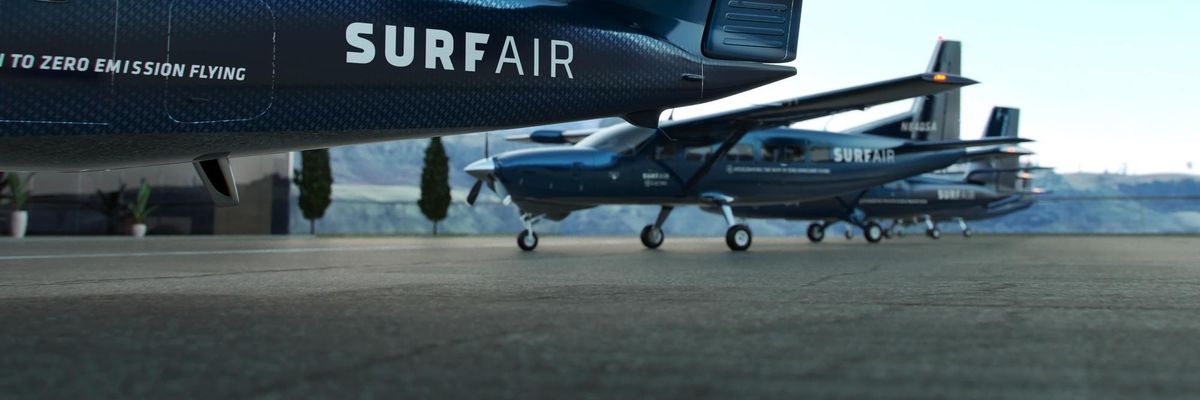

Get in the KNOW
on LA Startups & Tech
X
Courtesy of Surf Air Mobility
Meet Surf Air Mobility, the Startup Trying To Electrify Air Travel
Samson Amore
Samson Amore is a reporter for dot.LA. He holds a degree in journalism from Emerson College. Send tips or pitches to samsonamore@dot.la and find him on Twitter @Samsonamore.
The airline industry is a notoriously terrible polluter, with large carriers struggling to find ways to limit the more than 915 million tons of carbon emissions produced by their industry each year.
Yet some startups, like Hawthorne-based Surf Air Mobility, are looking to the electrification of air travel as a possible solution. On Wednesday, Surf Air announced it will go public by merging with blank-check company Tuscan Holdings Corp and Florida-based commuter airline Southern Airways, in a deal that values the combined company at $1.42 billion. The transaction is expected to raise up to $467 million, giving Surf Air much-needed capital to expand its vision for a fully electric airline.
Co-founded by CEO Sudhin Shahani and Chief Brand Officer Liam Fayed in 2012, Surf Air is a charter flight service with an electrified twist. Its single-engine, eight-seater Pilatus PC-12 aircraft is capable of a 2,150-mile flight range and a max speed of 330 miles. While that’s not as long nor as fast as most major commercial airplanes, it suits the carrier’s regional flights between local airports across the country, which are available to members who pay a starting rate of $199 per month.
Surf Air has stacked a notable slate of investors and advisors in recent years. Chairman Carl Albert is an airline industry veteran; he was CEO of turboprop charter airline Wings West before it was acquired by American Airlines and also ran manufacturing outfit Fairchild Aircraft for a decade. Other notable investors include billionaire businessman and Los Angeles mayoral candidate Rick Caruso, banking heir Alexandre de Rothschild and Facebook co-founder Eduardo Saverin, as well as local venture firms M13, Plus Capital and TenOneTen Ventures.
Though Surf Air has been eyeing an IPO since 2020, Shahani told Bloomberg that the startup’s business really took off during the pandemic, when many travelers who could afford charter flights were eager to skip larger, more crowded planes and airports. The newly merged company expects to generate roughly $100 million in revenue across all of its business units in 2022, it said Wednesday. “We’ve grown 50% last year to this year,” Shahani told Bloomberg.
The company aims to electrify all of its regional flights through the development of both an original hybrid and electric powertrain, which it can use to retrofit turboprop aircraft like its fleet of Cessna Grand Caravans and create fully electric planes. It also hopes to expand to more terminals—something that will be aided by the merger with Southern Airways, which serviced 39 cities and 300,000 customers last year.
Surf Air says that if it achieves that vision, it’ll be able to completely neutralize its emissions while reducing operating costs by half. Right now, Surf Air says its hybrid planes in action are producing half the emissions of a standard flight while saving about a quarter of the cost. The company doesn’t have a deadline on when its fully electric powertrain will be ready, but announced a deal Thursday with aircraft developer AeroTEC and propulsion firm Magnix to make more hybrid electric powertrains for its Cessnas, which could speed up the timeline.
Surf Air’s competitors in the realm of flight electrification include Textron, Cape Air and NASA, which started testing electric planes two years ago. Another airline, Hawaiian Air, is invested in a company that makes electric sea gliders, while Boeing is also testing electric planes. According to a recent report from the National Renewable Energy Laboratory, there are 170 similar projects underway.
“We believe deploying hybrid electric propulsion technology on existing aircraft at scale will be the most significant step we can take toward decarbonization of aviation in this decade,” Shahani said in a statement Wednesday. “We’re at a moment when the increasing consumer demand for faster, affordable, and cleaner regional travel will be met with [Surf Air]’s electrification ecosystem to accelerate the industry’s adoption of green flying.”
From Your Site Articles
- Surf Air Plans IPO and Gets a $200 Million Lift - dot.LA ›
- Surf Air Mobility, Skydance Media Land $400M Investments - dot.LA ›
Related Articles Around the Web
Samson Amore
Samson Amore is a reporter for dot.LA. He holds a degree in journalism from Emerson College. Send tips or pitches to samsonamore@dot.la and find him on Twitter @Samsonamore.
https://twitter.com/samsonamore
samsonamore@dot.la
Rivian Stock Soars 29% in Its Nasdaq Debut, Topping Ford and GM
01:44 PM | November 10, 2021
Rivian has yet to prove it can compete with the likes of Tesla and General Motors, but investors are snapping up shares anyways, driving the company's stock price up 29% from its debut price on the Nasdaq exchange .
Rivian priced its IPO at $78 per share, above the $72-to-$74 range initially set by the emerging automaker, to raise almost $12 billion. By that measure, the electric truck and van manufacturer's IPO was the largest in the U.S. since Facebook's public-market debut way back in 2012.
Trading under the symbol "RIVN," Rivian's stock price peaked at $119.46 during the day before closing near $101 per share.
At that price, the company's market cap approached $87 billion, according to Nasdaq, blowing past Ford (at about $77 billion) and narrowly topping GM ($86 billion).
Rivian has a busy couple of years ahead of it. The waiting list for its first truck and SUV currently stretches to the end of 2023. Plus, the Irvine-based company still has to deliver thousands of electric vans to its largest investor: Amazon.
Rivian also faces a gender discrimination lawsuit from its former vice president of sales and marketing, Laura Schwab.From Your Site Articles
- Ex-Rivian VP Slowly Shut Out From Company Decisions - dot.LA ›
- Amazon Reveals Stake in Irvine EV-Maker Rivian - dot.LA ›
- Rivian IPO Filings Show Losses Before Going Public - dot.LA ›
- Rivian's Venice Hub Rethinks Auto Dealerships - dot.LA ›
- Ford and Rivian Nix Plans to Make Electric Vehicle Together - dot.LA ›
- Rivian, Fisker Get Pummeled Amid Stock Market Selloff - dot.LA ›
- Rivian Shares Spike After George Soros’ Investment - dot.LA ›
- Rivian Backtracks on Price Hikes, Reinstates Original Prices - dot.LA ›
- Will Rivian's Q4 Earnings Make or Break the Company? - dot.LA ›
Related Articles Around the Web
Read moreShow less
Harri Weber
Harri is dot.LA's senior finance reporter. She previously worked for Gizmodo, Fast Company, VentureBeat and Flipboard. Find her on Twitter and send tips on L.A. startups and venture capital to harrison@dot.la.
Bigger is Better: Ranking LA’s Biggest Funds of 2020
08:00 AM | December 28, 2020
If you were trying to close your new venture fund in the spring, you probably had a lot of sleepless nights and frantic Zoom meetings as limited partners tried to shore up their existing portfolios amidst Wall Street turmoil.
But after the initial shock from coronavirus wore off and public markets sharply rebounded, 2020 turned out to be a great year to raise a new fund, with the major caveat that you are well-established and raising lots of capital.
Bigger was definitely better.
U.S. venture capital funds raised a record $69.1 billion in 2020, according to Pitchbook data. And there were 14 mega-funds that hauled in $1 billion or more, the most since 2010.
Those included a pair of $4.5 billion mega-funds that Silicon Valley firm Andreessen Horowitz announced in November and a $1.8 billion vehicle Lightspeed, another Valley firm, closed in April.
But while the total amount of capital hit new highs, it was raised by far fewer firms. Smaller firms that back early-stage startups are having a much harder time fundraising.
Los Angeles is known for those smaller funds, but despite headwinds, 2020 saw some standouts.
B Capital Group closed a $822 million second fund in June with Boston Consulting Group (BCG) taking the lead as anchor investor. It was more than twice as big as the firm's $360 million debut fund.
B Capital Group was founded in 2014 by Facebook co-founder Eduardo Saverin, who's based in Singapore, and Raj Ganguly, a former BCG investor who resides in Manhattan Beach.
In November, Sinai Capital Partners announced the close of its $600 million second fund, $500 million of which will go towards the tech-focused Sinai Ventures and the rest to fund movies and television shows at New Slate Ventures. All the capital comes from a reclusive German billionaire.
The firm is run by Jordan Fudge, who stands out in the overwhelmingly white and older world of VC because he is Black, openly gay and only 28-years old. With the most recent raise, he now presides over nearly a billion dollars in capital.
Westlake Village BioPartners, the two-year-old firm focusing on life science and therapeutic companies, announced this month it has raised two new funds with $500 million in dry powder.
Last month, March Capital closed a $365 million third fund, according to SEC filings. The Santa Monica venture firm focusing on enterprise software was founded by Jim Armstrong, Jamie Montgomery, Gregory Milken and Sumant Mandal in 2014.
The firm has reaped a billion dollar-plus paper return on the 6.8 million shares it holds in the cybersecurity company CrowdStrike.
Data from Pitchbook and dot.LA. Lead art by Candice Navi.
From Your Site Articles
- LA Venture Capital Survey Sees Hiring Ahead - dot.LA ›
- Jordan Fudge Raised One of the Largest Funds in LA History - dot.LA ›
- VCs Fund More Early Stage Female Founders in LA - dot.LA ›
- The Largest Venture Capital Raises in Los Angeles in 2020 - dot.LA ›
- Austin Clements and His New Fund for Black Entrepreneurs - dot.LA ›
Related Articles Around the Web
Read moreShow less
march capitalwestlake village biopartnersjordan fudgesinai capital partnerseduardo saverinraj ganhulybcgb capital groupcrowdstrikejim armstrongjaime montgomerygregory milkensumant mandalventure capitalvc sentiment survey
Ben Bergman
Ben Bergman is the newsroom's senior finance reporter. Previously he was a senior business reporter and host at KPCC, a senior producer at Gimlet Media, a producer at NPR's Morning Edition, and produced two investigative documentaries for KCET. He has been a frequent on-air contributor to business coverage on NPR and Marketplace and has written for The New York Times and Columbia Journalism Review. Ben was a 2017-2018 Knight-Bagehot Fellow in Economic and Business Journalism at Columbia Business School. In his free time, he enjoys skiing, playing poker, and cheering on The Seattle Seahawks.
https://twitter.com/thebenbergman
ben@dot.la
RELATEDTRENDING
LA TECH JOBS


